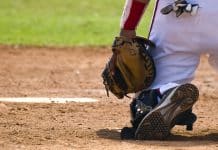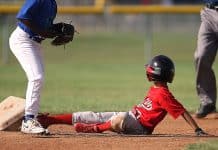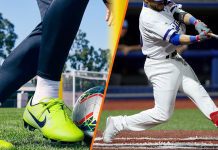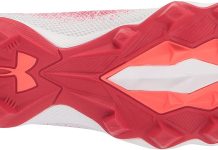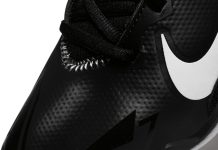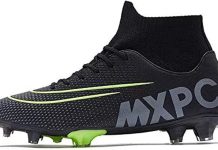When selecting the right baseball cleats, deciding between low-top and mid-top can leave us feeling stumped.
With both options having unique advantages, weighing the factors that suit our playing style and preferences is essential.
This article aims to provide insights into the differences between low-top and mid-top baseball cleats, helping you make an informed decision that enhances your performance on the field.
So, let’s lace up and explore the world of baseball footwear.
Factors to Consider When Choosing Baseball Cleats
When it comes to choosing the right baseball cleats, there are several important factors to keep in mind. Each factor plays a crucial role in determining the overall performance and comfort of the cleats. By carefully considering these factors, you can ensure that you make an informed decision and find the perfect pair of cleats for your needs.
Review contents
Playing Position
First and foremost, you should consider your playing position on the field. Different positions require different levels of agility, stability, and support. For example, infielders need to be quick on their feet and require cleats that offer excellent traction and flexibility.
On the other hand, outfielders need cleats that provide enhanced stability for making swift movements and quick direction changes. Pitchers need cleats with good ankle support and cushioning to handle the repetitive pitching motions. Additionally, catchers need cleats that focus on durability and ankle support due to the high-impact nature of their position.
Playing Surface
Another crucial factor to consider is the playing surface you’ll be playing on. The three main types of surfaces in baseball are grass, artificial turf, and dirt. Each surface has different characteristics that can affect your cleat choice. Grass surfaces require cleats with longer studs to provide maximum traction and prevent slipping.
Artificial turf, on the other hand, requires cleats with shorter studs or specialized turf shoes to avoid damaging the surface. Dirt fields fall somewhere in between, usually requiring a versatile cleat with a good balance of traction and durability.
Ankle Support
Ankle support is essential for preventing injuries and providing stability during gameplay. The level of ankle support you need depends on various factors, including your history of ankle injuries and the demands of your playing position. Low-top cleats provide minimal ankle support, but offer increased agility and maneuverability.
They are suitable for players with a lower risk of ankle injuries and positions that require quick movements. On the other hand, mid-top cleats offer moderate ankle support, providing a balance between support and mobility. These are ideal for players who need more stability without sacrificing agility.
Comfort
Comfort should be a top priority when choosing baseball cleats. After all, you’ll be spending hours on your feet during practices and games. Factors such as fit and sizing, cushioning and padding, and arch support can significantly impact your comfort level.
It’s essential to try on different cleats and ensure they fit snugly without being too tight or too loose. Look for cleats with adequate cushioning and padding, especially in the midsole and heel areas, to absorb impact and provide added comfort. Cleats with proper arch support will also help prevent foot fatigue and discomfort.
Flexibility
Flexibility is another essential factor, as it directly affects your ability to move efficiently on the field. Cleats that are too stiff can restrict your range of motion and hinder your performance.
Look for cleats that offer sufficient flexibility in the forefoot area, allowing for natural movement and quick directional changes. This will enable you to react swiftly to different game situations and perform at your best.
Weight
Considering the weight of the cleats is vital for optimizing your speed and agility. Lightweight cleats can enhance your performance by reducing the extra burden on your feet. Low-top cleats are typically lighter than mid-top cleats due to their minimal design.
The reduced weight allows for faster movements and increased speed on the field. However, finding the right balance between weight and other factors is essential, ensuring that the cleats offer adequate support and durability.
Durability
Durability is another crucial factor, as baseball cleats are subjected to rigorous use and harsh conditions. The last thing you want is for your cleats to wear out or lose their grip mid-game. Look for cleats made from high-quality materials that can withstand the demands of the game.
Reinforced toe caps and durable outsoles are essential for long-lasting performance. It’s also worth considering cleats with additional features like water resistance or abrasion-resistant overlays for added durability.
Style and Design
While not a make-or-break factor, the style and design of the cleats can play a role in your decision-making process. Feeling confident and comfortable in your cleats can positively impact your performance on the field.
Many brands offer styles and color options, allowing you to find cleats that reflect your taste. However, it’s important not to prioritize style over the more essential factors when choosing cleats.
Price
Price is undoubtedly an important consideration for most players. Baseball cleats can vary significantly in price, depending on the brand, features, and materials used. Setting a budget and looking for cleats that offer the best value for your money is essential. However, it’s crucial not to compromise on quality and performance solely to save a few dollars. Invest in a pair of cleats that will provide the durability and performance you need for a successful season.
Brand Reputation
Lastly, considering the brand reputation can give you an idea of the quality and reliability of the cleats. Opting for recognizable and trustworthy brands with a strong presence in baseball can give you peace of mind, knowing that you’re investing in a reputable product. Well-established brands often have a history of producing high-quality cleats trusted by professional athletes and players.
Advantages of Low-top Baseball Cleats
Low-top baseball cleats offer several advantages, making them popular among players.
Increased Agility
One of the main advantages of low-top baseball cleats is their ability to enhance agility on the field. The low profile of these cleats allows for greater freedom of movement, enabling players to make quick and precise movements. Whether making a sudden stop, pivoting, or sprinting, low-top cleats provide the flexibility and maneuverability needed for agile gameplay.
Lightweight
Low-top cleats are typically lighter than their mid-top counterparts. The reduced weight helps players feel lighter on their feet and adds to their overall speed. Lighter cleats can contribute to increased acceleration and quicker reaction times, giving players an edge on the field. The lightweight nature of low-top cleats allows players to move faster without feeling weighed down.
Breathability
Another advantage of low-top cleats is their improved breathability. These cleats often feature more open designs or mesh panels, allowing for better airflow. This helps to keep the feet cool and dry, reducing the chances of discomfort and blisters caused by excess moisture. The breathability of low-top cleats can contribute to overall comfort, especially during long games or practices.
Disadvantages of Low-top Baseball Cleats
While low-top baseball cleats offer some significant advantages, they also come with a few drawbacks that players should consider.
Lack of Ankle Support
One of the main disadvantages of low-top cleats is their limited ankle support. The low-cut design exposes the ankles, making them more susceptible to twists, sprains, and other injuries. Players with a history of ankle injuries or those who require extra support for their playing position may find that low-top cleats do not provide adequate stability.
Less Protection from Injuries
Low-top cleats offer less protection to the feet and lower leg than mid-top cleats. The minimal design and lack of additional padding or reinforcement can leave players more vulnerable to impacts from balls, collisions with other players, or objects on the field. While low-top cleats provide greater mobility and agility, players should consider the potential trade-off in terms of protection.
Advantages of Mid-top Baseball Cleats
Mid-top baseball cleats strike a balance between ankle support and mobility, offering several advantages for players.
Moderate Ankle Support
One of the main advantages of mid-top cleats is the moderate ankle support they provide. The slightly higher cut of these cleats offers more stability to the ankles than low-top cleats without restricting mobility too much. This can be beneficial for players who require a bit more support but still need the freedom to move quickly on the field.
Improved Stability
Mid-top cleats offer improved stability compared to low-top cleats. The higher cut provides additional support to the ankle, which can help players maintain balance and prevent potential injuries. This added stability can be particularly useful for players who engage in high-impact activities or have a history of ankle injuries.
Added Protection
With their higher cut and additional padding, mid-top cleats offer more protection to the feet and lower leg compared to low-top cleats. The increased coverage can help reduce the risk of injuries from impacts such as foul balls, twisted ankles, or collisions with other players. The added protection can give players peace of mind and confidence in their ability to play the game without unnecessary risks.
Disadvantages of Mid-top Baseball Cleats
While mid-top baseball cleats offer some significant advantages, they also have a few drawbacks that players should be aware of.
Restricted Ankle Mobility
One of the main disadvantages of mid-top cleats is their potential to restrict ankle mobility compared to low-top cleats. The higher cut offers more ankle support but can also limit the range of motion when making quick movements or sudden changes in direction. Players who rely heavily on their agility and need maximum ankle mobility may find mid-top cleats to be too restrictive.
Heavier than Low-top Cleats
Another drawback of mid-top cleats is their slightly heavier weight compared to low-top cleats. The additional materials and padding that support the ankle can contribute to a slightly heavier overall shoe. While the weight difference may not be significant, players who prioritize speed and quickness may prefer the lighter feel of low-top cleats.
Choosing Based on Playing Position
Different playing positions have different demands, and choosing cleats that align with those requirements is essential.
Infielders
Infielders need cleats that prioritize agility and traction. Quick lateral movements and rapid changes in direction are every day in this position. Infielders often prefer low-top cleats due to their lightweight design and increased mobility. The ability to make quick, precise movements and maintain excellent traction on the field is essential for success as an infielder.
Outfielders
Outfielders cover larger field areas and often need more ground while tracking down fly balls. The stability and support provided by mid-top cleats can be beneficial for outfielders. These cleats offer better ankle support for running and jumping, allowing outfielders to make confident plays without compromising mobility. Additionally, cleats with enhanced traction are crucial for outfielders to react quickly to changing game situations.
Pitchers
Pitchers have unique demands on the field, requiring a balance between ankle support, comfort, and mobility. Mid-top cleats can provide the necessary ankle support to handle the repetitive motions involved in pitching. Additionally, cushioning and shock absorption in the cleats’ construction are vital to alleviate the impact on the feet and legs during the pitching motion. Choosing cleats with a good grip is also necessary to maintain mound stability.
Catcher
Catchers need cleats that prioritize durability and ankle support due to the physical demands of their position. With frequent squatting and sudden movements, catchers put significant stress on their ankles and feet. Mid-top cleats with reinforced toe caps can provide added protection against foul tips and other impacts, while ankle support helps prevent injuries from squats and sudden accelerations. Look for cleats with ample cushioning and padding for comfort during long games.
Considering the Playing Surface
Different playing surfaces require different cleat types to optimize traction and performance.
Grass
Cleats with longer studs are ideal for maximum traction when playing on grass fields. These studs penetrate the ground surface, preventing slipping and enhancing stability during quick movements. Choosing cleats with durable studs that can withstand frequent use on grass without wearing down is essential. Cleats with interchangeable studs may be beneficial, as different lengths can be used for different field conditions.
Artificial Turf
Artificial turf surfaces are becoming increasingly popular, especially in practice facilities and some stadiums. Cleats explicitly designed for turf offer superior performance on this type of surface. These cleats typically have shorter, rubberized studs or a nubbed sole, which provides adequate traction without damaging the turf. It’s important to avoid using cleats with long studs or metal spikes on artificial turf, as they can cause damage to the playing surface.
Dirt
Dirt fields present a combination of grass and packed soil, often requiring cleats to handle both elements. Versatile cleats with a balance between stud length and durability are ideal for dirt fields. These cleats should provide enough traction to grip the dirt surface while still allowing for quick movements on grass areas. Cleats with a durable outsole and well-spaced studs can provide the necessary traction on dirt fields.
Evaluating Ankle Support
Ankle support is a crucial factor that can help prevent injuries and provide stability on the field.
History of Ankle Injuries
If you have a history of ankle injuries, it’s crucial to prioritize ankle support when choosing baseball cleats. Players who have previously suffered from sprains or other ankle-related injuries may benefit from mid-top or high-top cleats, as these provide additional stability and help reduce the risk of re-injury. Consult with a medical professional or athletic trainer to determine the level of ankle support you should prioritize based on your injury history.
Preventing Further Injuries
Even if you haven’t had previous ankle injuries, it’s still essential to consider ankle support to minimize the risk of future injuries. Pay attention to the demands of your playing position and the movements involved. If your position requires frequent lateral movements, sudden changes in direction, or high-impact activities, cleats with good ankle support can provide added confidence and stability on the field. Remember that preventing injuries is essential for maintaining your performance and enjoying the game.
Prioritizing Comfort
Comfort is a vital aspect to consider when choosing baseball cleats, as it directly affects your performance and enjoyment of the game.
Fit and Sizing
Proper fit and sizing are crucial for comfort and overall performance. Ill-fitting cleats can cause discomfort, blisters, and foot fatigue, negatively impacting your ability to perform at your best. Take the time to try on different cleats and ensure they fit snugly without being too tight or too loose. Consider the shape of your feet and any specific fit preferences, such as a roomier toe box or a narrow width.
Cushioning and Padding
Cushioning and padding play a significant role in providing comfort and shock absorption. Look for cleats with adequate cushioning in the midsole and heel areas to absorb impact from running, jumping, and other high-impact movements. Additionally, padding the collar and tongue can help prevent discomfort and irritation during gameplay. Consider your playing style, the length of games, and the overall level of cushioning you prefer.
Arch Support
Proper arch support is essential for maintaining foot stability, reducing fatigue, and preventing potential injuries. Flat-footed players or those with high arches should pay close attention to the arch support offered by different cleats. Some cleats have built-in arch support systems or removable insoles that can be customized to support your foot structure. Shoes with inadequate arch support can lead to discomfort, foot pain, and long-term problems.
Taking Brand Reputation into Account
Considering the brand reputation can offer insights into the quality and reliability of the cleats you’re considering.
Recognizable and Trustworthy Brands
Opting for well-established and recognizable brands can provide peace of mind when making a cleat purchase. Trusted brands with a strong presence in the baseball world often have a history of producing high-quality products.
These brands invest in research, technological advancements, and athlete feedback to improve their cleat designs continuously. While not a guarantee, choosing from reputable brands can increase the likelihood of finding a reliable pair of cleats performing well on the field.
In conclusion, choosing the right baseball cleats requires careful consideration of various factors. Factors such as playing position, playing surface, ankle support, comfort, flexibility, weight, durability, style and design, price, and brand reputation all play a crucial role in finding the perfect pair of cleats.
By thoroughly evaluating each factor and understanding its impact on your specific needs, you can make an informed decision that will enhance your performance and enjoyment of the game. When selecting your baseball cleats, remember to prioritize your comfort, safety, and individual playing style.





